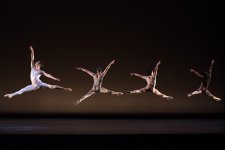Until and unless the Dance is well lighted, you will never get correct exposure with an F/4 lens with in-body flash. A powerful external flash may help, but low cycle time flash are extremely expensive.
A less expensive option is to get a faster lens. I have 35mm F1.8DX, that does wonders in low light, and is quite inexpensive. My recommendations are :
. Get the 35mm or 50mm F1.8 lens - mostly $150 - $200.
. Use Aperture priority at f1.8.
. Set the ISO at 400. Try a few shots. Check the speed if it is below 1/250, then raise ISO to 800, but definitely not beyond 1600.
. If the speed is still low, set exposure compensation to -1, that will double the speed. In effect you can shoot darker and then process the RAW to get correctly lighted images.
. Use single point focus - set to central point.
. Use spot metering.
. Shoot RAW and then use recover shadows to make the dark areas lighter. Remember that jpeg uses 8 bits, while the RAW in D3300 has 12 bits of information. That is the shadows can be made lighter 16 times to reveal information.
In case these settings still give you blurred images, then up the ISO in steps to 6400, but that will give a lot of noise. In that case the only recourse is to get a FF body which has much better high ISO characteristics.
One trick I learned is to time the shots when the dancers are relatively static - at the top or bottom of the jump. If you can time it perfectly you will get shots with practically no motion.
Download the free Nikon Capture NX-D. I have been using it ever singe they released it in 2014 and the shadow recovery functions are excellent.
A less expensive option is to get a faster lens. I have 35mm F1.8DX, that does wonders in low light, and is quite inexpensive. My recommendations are :
. Get the 35mm or 50mm F1.8 lens - mostly $150 - $200.
. Use Aperture priority at f1.8.
. Set the ISO at 400. Try a few shots. Check the speed if it is below 1/250, then raise ISO to 800, but definitely not beyond 1600.
. If the speed is still low, set exposure compensation to -1, that will double the speed. In effect you can shoot darker and then process the RAW to get correctly lighted images.
. Use single point focus - set to central point.
. Use spot metering.
. Shoot RAW and then use recover shadows to make the dark areas lighter. Remember that jpeg uses 8 bits, while the RAW in D3300 has 12 bits of information. That is the shadows can be made lighter 16 times to reveal information.
In case these settings still give you blurred images, then up the ISO in steps to 6400, but that will give a lot of noise. In that case the only recourse is to get a FF body which has much better high ISO characteristics.
One trick I learned is to time the shots when the dancers are relatively static - at the top or bottom of the jump. If you can time it perfectly you will get shots with practically no motion.
Download the free Nikon Capture NX-D. I have been using it ever singe they released it in 2014 and the shadow recovery functions are excellent.

